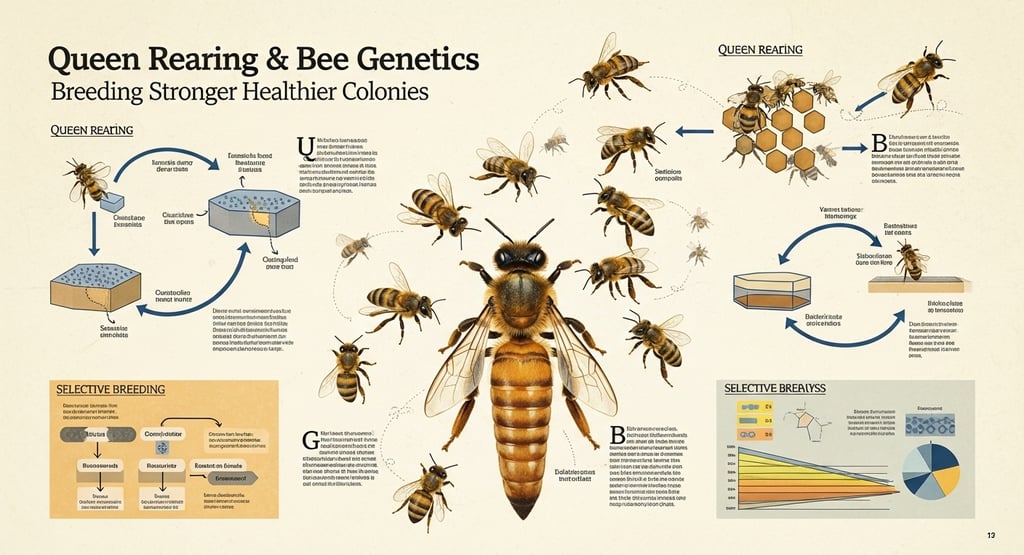Queen Rearing & Bee Genetics: Breeding Stronger, Healthier Colonies
The queen is the heart of every hive — her genetics and health determine colony temperament, productivity, disease resistance, and even survival rates across seasons.


Queen Rearing & Bee Genetics: Breeding Stronger, Healthier Colonies
Introduction
Strong colonies begin with exceptional queens. Whether you’re a passionate hobbyist or running a commercial apiary, effective queen rearing and smart genetic selection are game changers. They influence honey yields, disease resistance, temperament, and overall hive success.
At Heliotrope Bee, we support beekeepers worldwide not just with premium protective gear, but also with insights and professional logistics for scaling queen-rearing efforts safely and consistently.
1. Understanding Queen Bee Biology
1.1 Role of the Queen:
Lays up to 2,500 eggs per day in prime season
Produces pheromones that maintain hive cohesion and worker behavior
1.2 Distinct Characteristics:
Lived significantly longer than workers or drones (2–6 years)
Fed continuously with royal jelly during her development
Primary determinant of colony traits—health, productivity, temperament
2. Key Traits for Selection
A robust queen imparts traits to the colony. Focus on:
Temperament: Calm colonies are easier to manage
Productivity: High brood rates increase workforce density
Disease/Parasite Resistance: Better survival in high-Varroa or Nosema zones
Overwintering Success: Critical for cold climates
Pollen Collection Traits: Superior performance in pollination contracts
Heliotrope Bee welcomes discussions on local adaptation and rearing support to complement your protective gear choices.
3. Queen Rearing Methods
3.1 Grafting:
Transfer of young larvae into artificial queen cups
Requires precision tools and trained hands
Ideal for controlled breeding of elite traits
3.2 Natural Queen Cell Production:
Allowing colonies to create supersedure or swarm queen cells
Simpler, less labor-intensive, but with less control over lineage
3.3 Kit-Based Mating Nucs:
Using small nucleus hives for safe, isolated queen rearing
Provide queens room to mate and laying space for observation
3.4 Artificial Insemination (AI):
Research-level technique for precise genetic control
Requires special equipment, scientifically managed environments
4. Genetic Line Maintenance & Recordkeeping
Record Systems:
Track queen lineage, mating dates, and hive performance
Utilize tags, QR codes, or RFID for quick identification
Genetic Diversity Considerations:
Prevent inbreeding by rotating drones or sourcing from diverse stock
Maintain healthy alleles for long-term hive vigor
Modern hives with protective gear—like Heliotrope Bee's suits—make fieldwork smoother and safer during these detailed operations.
5. Queen Introduction & Establishment
Match queen pheromone output with brood frame ratios
Quietly introduce caged queen into the new hive area
Watch for queen acceptance via brood pattern changes post-release
A calm beekeeper, assisted by leak-proof suits and smooth gloves, significantly increases acceptance success.
6. Artificial Insemination Overview
While advanced, AI ensures control over genetic traits:
Requires hygienic lab conditions to prevent contamination
Used in elite breeding programs for research and resilience
Protected field attire is crucial to maintain clean rearing conditions
7. Scaling Queen Production
Commercial programs often require hundreds or thousands of queens annually. Best practices include:
Creating queen-rearing schedules in spring and summer
Organizing mating yards during nectar flows
Training staff with SOPs for grafting, marking, and record-keeping
Preparing protective gear logistics—Heliotrope Bee supports bulk orders with branding and quick shipping
8. Supporting Sustainable Operations
Support regional interactions—healthy queens = resilient ecosystems
Coordinate shipments using safe box designs with climate controls
Educate on genetically diverse queen rearing using Heliotrope Bee’s training guides and gear partnerships
9. Enhancing Business Potential
Quality queens are a revenue source:
Selling queens at set prices and building brand reputation
Provide queen-rearing workshops for local or international beekeepers
Partner with regulatory bodies—elevate industry standards with well-documented practices
10. Safety, Efficiency, and Innovation
Precision queen work requires:
Static-free suits
High-visibility veils
Extra-dexterous gloves for micro-manipulation
Protection from accidental propogation of disease
Heliotrope Bee continues to refine gear for these exacting field uses.
Conclusion
Effectively managing genetics and queen rearing enhances hive health, productivity, and your apiary's reputation. With attention to biological best practices and thoughtful garment choices, beekeepers can elevate every aspect of their craft.
Heliotrope Bee stands ready to support your next breeding cycle with protective, high-performance gear tailored for finesse and safety.


